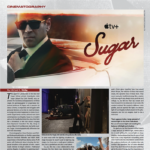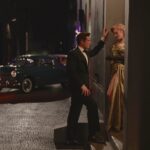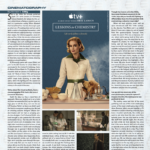
Cinematographer Matthew Libatique is a two-time Academy Award nominee for Best Achievement in Cinematography; recognized for Black Swan and A Star Is Born. He has had long working relationships with directors, including Darren Aronofsky, Spike Lee and Jon Favreau, as well as equally successful projects working with directors like Bradley Cooper, and now Olivia Wilde on Don’t Worry Darling.
Embracing a heightened realism to create the film’s 1950s world of a seemingly utopian community, Libatique used color, the fortuitous timing of the shoot, and the nature of the location itself to great effect.
In a wonderful bit of inspiration and creation coming together, Libatique got to shoot in the exact location that was also the main reference point for he and Wilde when working on the look and feel for the film during planning. Among the locations for the film in Palm Springs, CA, a haven of midcentury modern architecture, Don’t Worry Darling was the first film to shoot at the renowned Kaufmann Desert House. The iconic home was the backdrop for the famous Slim Aarons’ 1970 photograph Poolside Gossip, which both the director and cinematographer were drawn to early on. A fitting photo to inspire the team to evoke the feeling that Libatique captures so masterfully in the highly stylized Don’t Worry Darling.
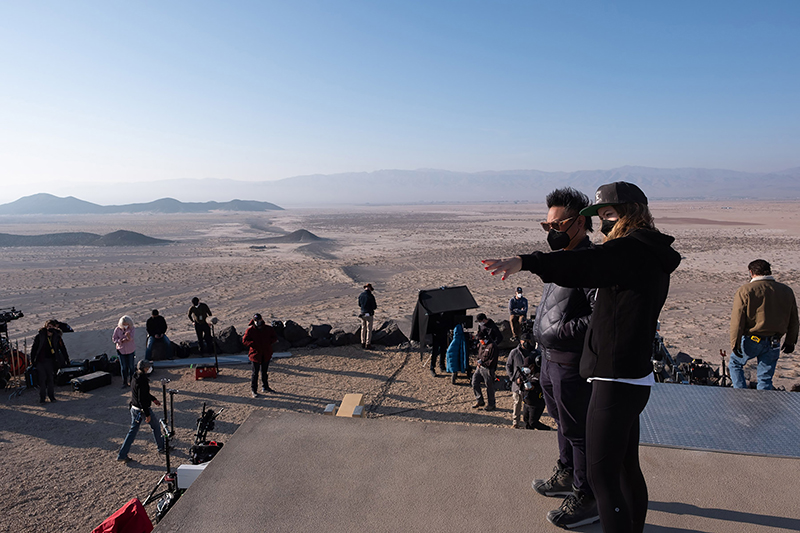
How did you balance a stylized 1950s look and feel with naturalism to capture the look that Wilde wanted for this film?
We had the intention of approaching the cinematography and the look of the movie—from at least my perspective—by creating a naturalism within the world, which was an effort to try to root the film, and this world, into a believable place; a place that people exist even though the world was heightened by its style and its content.
We were the fortunate benefactors of shooting in Palm Springs in November, in fact, if we didn’t have the benefit of shooting in November in Palm Springs, I think it would’ve been a completely different story. It afforded us the ability to use the sun path of the actual location and literally mimic it in the interior location shot on a stage. I think that really bridged the gap between those two spaces and made for a seamless relationship between our exteriors and interiors, which I’m proud of accomplishing.
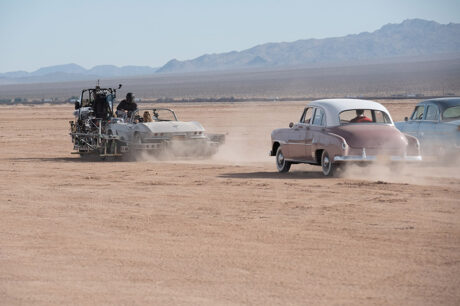
Since you did shoot the exteriors on location and the interiors on a stage, were there a lot of composite shots and did you use any backdrops?
There are actually only two, maybe three, shots that are composites that we look at the front door at different times of the day. There are maybe three in the film and that’s it. When you look at the back of the house, which has the lion’s share of the windows, that was a [digitally printed] backing drop by Rosco. We had two backings, the night drop and the day drop, that were shot on location. I feel we made some good choices there. I wanted to try to shoot it in a way that didn’t have to rely on visual effects; that was the aim for everybody. Obviously, budgetarily it helped, but also, we wanted to shoot the effect in-camera so we created these two custom-made backings.
I opted to shoot with the Arriflex Alexa Mini LF camera for the larger sensor, so we had a little more focus fall off on the wider focal lengths and just to exploit that and use it. We even used it at night. We’d light up the backing and have the reflections. There’s one moment where [the character] Alice comes back into consciousness after going into one of her “trances;” she enters her mind space. She’s at the glass doors of her bedroom when she hits her head on the glass door, and then we dim up the backing to be in reflection when we transition back into her “real world.” That is one example, the backings really worked out so well for us and we were able to exploit them in many, many ways without the need for, or cost of, visual effects. From a technical standpoint, I think it was quite an achievement for us. I have used backings quite a few times before, but I don’t know that I’ve used one to this extent that was so showcased.
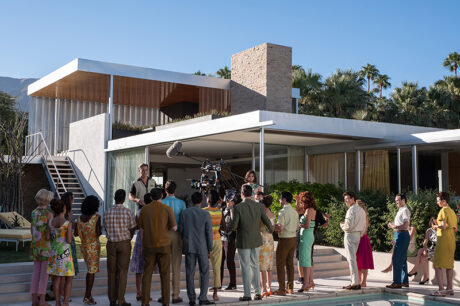
Talk a bit about filming at the Kaufmann House.
It’s a historic place that you handle with kid gloves, but there are so many wonderful angles there obviously. Slim Aarons was a huge reference for us; that iconic photo [Poolside Gossip] at the pool, we kept that on hand. When you stand there, you see the photograph; you wonder where he was standing as he shot that. It is a great location, just from every angle. Even in the interior, walking through it; it was just very fun to compose at this place. There was actually even more stuff that didn’t make the film that we shot in the front of it, which showed even another angle of the house; it was pretty exciting. The mid-century modern architecture of Palm Springs really lends itself to composition.
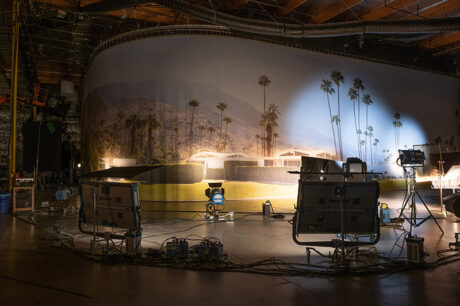
What were some of the things you did with lighting to perhaps hint at something under the idyllic appearance, perhaps create a little unease in the audience?
There’s a scene inside Alice and Jack’s bedroom where they’re sleeping. We were faced with the old challenge of motivating light when there is no light, thankfully, we had previously established backyard practicals leading up to the shooting of this scene which we used for motivation. We focused the light through the narrow space between closed curtains which created this very ominous shape of light on the floor, on the bed. Not that I was aiming to emulate a swastika, but there was something very Fascist about the shape of the light that felt like a reference to Frank’s [Chris Pine] Victory celebration.
Other than that, I actually didn’t want to create unease necessarily, because I was trying to actually make it feel like it was as real as possible. I mean, between the architecture and the clothing and the design of the film—it was so shiny to begin with, and rightly so, and it put us in the time period. I thought that the way to approach it from the cinematography was to try to make it as realistic as possible. And the notion of not necessarily lighting the frame, but letting the frame find the light and being a little broader with the lighting, was the approach I took.
I did have an interesting technique, using a device called the Color Con which is a series of single RGB LEDs embedded inside a 4×5 or 6×6 filter tray. The light, controlled by our programmer, is designed to control the contrast level of a scene by raising or lowering the intensity of the light that falls on a diffusion filter of your choice. I typically used a 1/8 or 1/4 Glimmer Glass. There are a couple of moments in the film where we introduce the effect; what it does is it creates a wash of color in the shadows of the image so we’re baking something into the file. I used it when she was getting lobotomized as it would flash green there and then every time she was entering the headquarters and made that transition, I used the Color Con to create a wash of red on the lens.
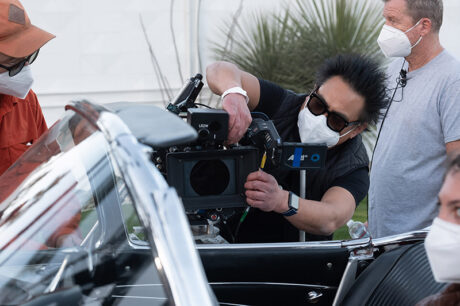
Speaking of color, talk about how you accentuated color choices of the production design and costumes as well as skin tones.
I like to test as much as possible, even in digital, primarily because when you create the lookup table, (LUT), you want to customize it to the movie you’re trying to shoot. So early tests were where we tried to get as much color into the frame as possible. I’d work with [Digital Intermediate Colorist] Alex Bickel, our colorist, on creating a LUT that would accentuate those colors but not affect skin tones. We had a couple of custom LUTs made, one of which was our hero LUT, and that was really to accentuate certain colors that were within the palette—the reds and oranges and yellows—but then not affect skin tones necessarily to where they were oversaturated.
So, it was a bit tricky, but the color science there was pretty specific. We also created a custom LUT where I cheated the ISO of the LUT so it was actually pushing the file one stop so I could use less light. It was my ‘get out of jail’ LUT in case I was in a night exterior, and I needed a little extra and I didn’t have it. We could apply that in the dailies. But, by and large, we used one lookup table for the entire film, and it was specifically designed to accentuate the colors that were in the clothing, production design, and the hair and the makeup and also lipstick while preserving the natural skin tones of everyone.
Is there a scene you really feel captured what you were trying to do as a cinematographer on this film?
I think in the first scene you get a sense that the light is naturalistic and there’s no camera angle that is manicured. I never really have a favorite scene because I look at the film as a whole, but I do appreciate that particular scene because it does set the tone for the movie. The camera is moving around freely in the space and that scene sets up that you are in this idyllic place where people are having a great time and there’s debauchery, there’s fun, there’s sex. It’s provocative. I thought the photography needed to feel as real as possible. It felt warm. It felt like an interior night. There was a freedom to it, like a person walking through a party and it felt like the POV of the audience. As I said, I feel like that set the tone for the movie in terms of how the light was going to play for the rest of the film.
Tell me about working with your Camera and Electrics team, especially Gaffer Jeff Ferrero and Key Grip Tana Dube.
Whatever the director conveys to me in terms of how she wants to approach the film, it’s my responsibility to convey it to my gaffer and key grip because they are ultimately the foremen in charge of making sure where everything goes. I might say it needs to be a 5K and more times than not, the gaffer is going to tell me, “No, it needs to be 10K, because you want it to be there. If you want to be further away, we’re going to need a 20K.” So, Jeff is a great protector of me. Which I always appreciate. Also, Jeff and Tana are both filmmakers first and foremost. As great as they are technically, they understand the environment we’re trying to create as filmmakers is to keep the thing moving forward. They allow me space, and even when sometimes I restrict myself, they’re always attuned to what the camera is going to be doing. They’re prepared to allow space, to pan the camera so that there’s very little restriction in terms of shooting a scene. It’s an effortless thing. It doesn’t seem like heavy lifting; you don’t feel the pressure even though there’s a lot of pressure on time and there’s a pressure of creativity and there’s a pressure of accomplishing the director’s vision. Both Tana and Jeff are always thinking ahead. As a team, I think we do really well. I love the collaboration because we can talk technically about what the quality of light is or what the unit might be, but moreover, it’s a discussion about the overall creativity and atmosphere of the film. I’ve done maybe six, or seven films with Jeff and it’s been the case every single time.
What’s a piece of old school technology you still rely on?
A light meter.
What’s some newer technology you’re using these days?
A [Convergent Design] Odyssey waveform monitor. It’s my digital light meter.
Any other aspect of working on Don’t Worry Darling that I perhaps didn’t ask about?
The film had big aspirations, but the budget was fairly modest. There is a big action sequence at the end and on a larger film, there would be a second unit and somebody else putting that sequence together. On Don’t Worry Darling that was left to us; neither Olivia nor I are known for action. So, I am proud that Olivia and I built that action sequence together. She was really excited about shooting it, and for me, it was really fun to put a different hat on; to really build that sequence as a cinematographer. I enjoyed having to go do research about something I didn’t know and find the proper equipment. We did have a stunt coordinator who was wonderful, and I would often go to her and say, ‘what if we used this?’ and ‘maybe we’ll do that,’ and ‘how do we achieve this?’ It’s not typically the kind of thing I do, yet it made me feel more useful actually to not know what the Hell I was doing and having to do the research. We both had a goal to create, as Olivia said to me, ‘a badass action sequence’, and I think we really did. There was a lot of pressure on us to create a good third act; something that was impactful. In the final product, the sequence is really a person going from point A to point B, but everything that we wanted to happen in-between I feel like we accomplished. You always have different experiences on films that make you remember it and that’s pretty much the thing I remember the most about Don’t Worry Darling. I am proud of that; I am actually proud of the whole film.
New Line Cinema’s Don’t Worry Darling, a Warner Bros. Pictures release, is in cinemas now.
